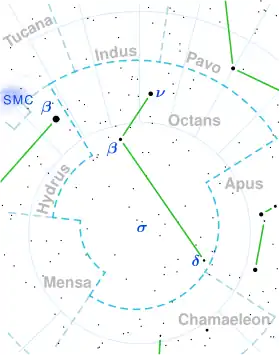Lambda Octantis
λ Octantis, Latinized as Lambda Octantis, is a binary star[3] system in the southern circumpolar constellation of Octans.[10] It is visible to the naked eye as a dim point of light with a combined apparent visual magnitude of 5.27.[2] The distance to this system is approximately 398–409 light years, based on parallax, but it is moving closer with a radial velocity of −10 km/s.[7]
 | |
| Observation data Epoch J2000 Equinox J2000 | |
|---|---|
| Constellation | Octans |
| Right ascension | 21h 50m 54.56355s[1] |
| Declination | −82° 43′ 08.0450″[1] |
| Apparent magnitude (V) | 5.27[2] (5.64 + 7.25)[3] |
| Characteristics | |
| Spectral type | G8-K0III[4] + kA3hA7VmA8[5] |
| U−B color index | +0.47[6]/+2.20[5] |
| B−V color index | +0.75[6] |
| Astrometry | |
| A | |
| Radial velocity (Rv) | −10.18±0.13[7] km/s |
| Proper motion (μ) | RA: +69.803[7] mas/yr Dec.: −33.013[7] mas/yr |
| Parallax (π) | 8.1897 ± 0.0878 mas[7] |
| Distance | 398 ± 4 ly (122 ± 1 pc) |
| Absolute magnitude (MV) | +0.40[5] |
| B | |
| Proper motion (μ) | RA: +69.025[8] mas/yr Dec.: −25.496[8] mas/yr |
| Parallax (π) | 7.9685 ± 0.0570 mas[8] |
| Distance | 409 ± 3 ly (125.5 ± 0.9 pc) |
| Absolute magnitude (MV) | +2.20[5] |
| Details | |
| A | |
| Radius | 13.23+0.41 −0.50[7] R☉ |
| Luminosity | 102.4±1.3[7] L☉ |
| Temperature | 5,048+98 −76[7] K |
| Rotational velocity (v sin i) | 1.8[9] km/s |
| Age | 200[5] Myr |
| Other designations | |
| Database references | |
| SIMBAD | data |
The primary, designated component A, is an aging, yellow-hued star with a stellar classification of class G8-K0III[11] and a visual magnitude of 5.64.[3] Having exhausted the supply of hydrogen at its core, it has expanded and cooled off the main sequence, becoming a giant. At present it is about 200[5] million years old and has 13[7] times the girth of the Sun. This star is radiating 102[7] times the luminosity of the Sun from its swollen photosphere at an effective temperature of 5,048 K.[7]
The magnitude 7.25[3] secondary companion, component B, is an Am star with a class of kA3hA7VmA8.[5] This notation indicates it has the calcium K line of an A3 class star, the hydrogen lines of a cooler A7 main sequence star, and the metal lines of an A8 star. As of 2008, it lies at an angular separation of 3.233″ from the primary.[3]
References
- Van Leeuwen, F. (2007). "Validation of the new Hipparcos reduction". Astronomy and Astrophysics. 474 (2): 653–664. arXiv:0708.1752. Bibcode:2007A&A...474..653V. doi:10.1051/0004-6361:20078357. S2CID 18759600. Vizier catalog entry
- Anderson, E.; Francis, Ch. (2012). "XHIP: An extended hipparcos compilation". Astronomy Letters. 38 (5): 331. arXiv:1108.4971. Bibcode:2012AstL...38..331A. doi:10.1134/S1063773712050015. S2CID 119257644. Vizier catalog entry
- Eggleton, P. P.; Tokovinin, A. A. (2008). "A catalogue of multiplicity among bright stellar systems". Monthly Notices of the Royal Astronomical Society. 389 (2): 869. arXiv:0806.2878. Bibcode:2008MNRAS.389..869E. doi:10.1111/j.1365-2966.2008.13596.x. S2CID 14878976. Vizier catalog entry
- Houk, Nancy; Cowley, A. P. (1979). Michigan catalogue of two-dimensional spectral types for the HD stars. Vol. 1. Ann Arbor, Michigan: Dept. of Astronomy, University of Michigan. Bibcode:1978mcts.book.....H.
- Corbally, C. J. (December 1984). "Close visual binaries. III. Parameters and evolutionary status". Astronomical Journal. 89: 1887–1896. Bibcode:1984AJ.....89.1887C. doi:10.1086/113700.
- Mallama, A. (2014). "Sloan Magnitudes for the Brightest Stars". The Journal of the American Association of Variable Star Observers. 42 (2): 443. Bibcode:2014JAVSO..42..443M.Vizier catalog entry
- Brown, A. G. A.; et al. (Gaia collaboration) (August 2018). "Gaia Data Release 2: Summary of the contents and survey properties". Astronomy & Astrophysics. 616. A1. arXiv:1804.09365. Bibcode:2018A&A...616A...1G. doi:10.1051/0004-6361/201833051. Gaia DR2 record for this source at VizieR.
- Brown, A. G. A.; et al. (Gaia collaboration) (August 2018). "Gaia Data Release 2: Summary of the contents and survey properties". Astronomy & Astrophysics. 616. A1. arXiv:1804.09365. Bibcode:2018A&A...616A...1G. doi:10.1051/0004-6361/201833051. Gaia DR2 record for this source at VizieR.
- De Medeiros, J. R.; et al. (2014). "A catalog of rotational and radial velocities for evolved stars". Astronomy & Astrophysics. 561: A126. arXiv:1312.3474. Bibcode:2014A&A...561A.126D. doi:10.1051/0004-6361/201220762. S2CID 54046583. Vizier catalog entry
- "lam Oct". SIMBAD. Centre de données astronomiques de Strasbourg. Retrieved 2019-09-19.
- Hoffleit, D.; Warren, W. H. (1995). "Bright Star Catalogue". VizieR On-line Data Catalog: V/50. Originally Published in: 1964BS....C......0H (5th Revised ed.). 5050. Bibcode:1995yCat.5050....0H.